Which meters need to be replaced. How to change the electric meter in an apartment or a private house.
Every year the population uses in their families an increasing number of different household electrical appliances. At the same time, buying another powerful unit, we are simply happy with the purchase, not paying attention to the low throughput counter installed in the apartment. This is especially affected by old-style electricity meters, which have an accuracy class of 2.5 and which are not subject to verification. Receiving significant overloads, they can cause a fire, because it is in them that most often occurs short circuit. Thus, the old-style meter really endangers the lives and property of citizens.
Electric meters: terms of work
By their own specifications the mechanisms of each device operate in the standard mode in a certain period of time. For the meter, such a time interval is the interval between verifications. Only at this time the values measured by him are correct and correspond to reality. At the end of the term, a technical check of the electric meter is carried out for compliance with its necessary requirements, in other words, state verification.
Very most of housing stock in former USSR Built in the early 60's - late 80's. In all these houses, old-style meters were installed, whose service life has ended a very long time ago. Due to purely mechanical wear and tear, they cannot accurately record electricity consumption. And here there should be, first of all, the interest of the owner of the meter, so that the readings are reliable, because it is on them that the calculation for the consumed electricity is made.
In addition, the old meters themselves are low-ampere, and they cannot afford modern energy-intensive loads. household appliances. Therefore, now more and more often many people need to install more modern and accurate electricity meters with an accuracy class of 2.0.
Do I need to change the electric meter to a new one?
IN Lately very often during scheduled inspections comes to light a large number of old electricity meters with serious deviations from the norm: from mechanical 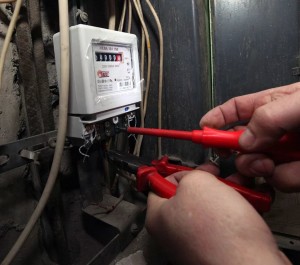 damage, before the expiration date. As a result of such checks, their replacement is recommended. If the recommendations are not followed, all consumed electricity is calculated according to the power of the appliances installed in the apartment. For the consumer, such a calculation is much more expensive than purchasing and. Installation and sealing of metering devices is carried out by a representative of the organization - the supplier of electricity.
damage, before the expiration date. As a result of such checks, their replacement is recommended. If the recommendations are not followed, all consumed electricity is calculated according to the power of the appliances installed in the apartment. For the consumer, such a calculation is much more expensive than purchasing and. Installation and sealing of metering devices is carried out by a representative of the organization - the supplier of electricity.
At self installation, the invited specialist should check the installation of the metering scheme. When correct installation schemes, the meter is sealed, after which its operation is allowed. In addition, the specialist draws up an act of replacement and takes the initial readings of the electric meter. Only after all these measures have been taken, the calculation for the consumed electricity will be made according to the readings of the new meter.
Reconstruction of electrics in a house or apartment, in particular the replacement of an electricity meter, sometimes becomes a stumbling block. Many face legal and technical questions, the answers to which are described in the article.
Replacing an old electricity meter: necessary documents and approval procedure
The need to replace the electricity meter may be due to different reasons: breakdown of the old meter, transition to a new model, expired operation of the device. To replace the meter, coordination with representatives of network services is required.
Important! Mandatory replacement of electricity meters is carried out if the accuracy class of the device is more than 2
To understand whether it is necessary to change the old meter, it is necessary to compare its characteristics with the standards given in the Information Table:
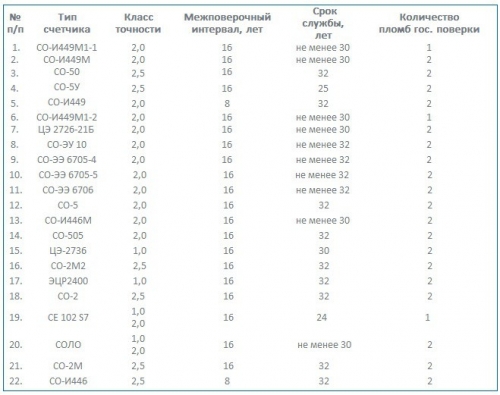
- Determine the date of the last inspection, which is indicated on the seal of the state inspection.
- Find out the year of manufacture of the meter used and its accuracy class - this information is displayed on the front panel of the device under glass.
Compare the information obtained with the table. If the data does not meet the requirements technical documentation counter needs to be replaced.
The general procedure for agreeing on the replacement of a metering device:
- Contact Mosenergosbyt and submit an Application for the replacement of an electricity meter, an electric meter passport. In the application, indicate the reason for replacing the device and the type of new meter.
- At the appointed time, he will contact the grid company with the electric meter. Specialists program the counter, issue permission to change equipment in a house or apartment.
- Having received permission, you can invite a specialist from Energosbyt or, if you have experience and knowledge, install it yourself.
- After the installation is completed, it is necessary to fill out the Commissioning Certificate of the electric meter and invite an employee of the Energosbyt for sealing.
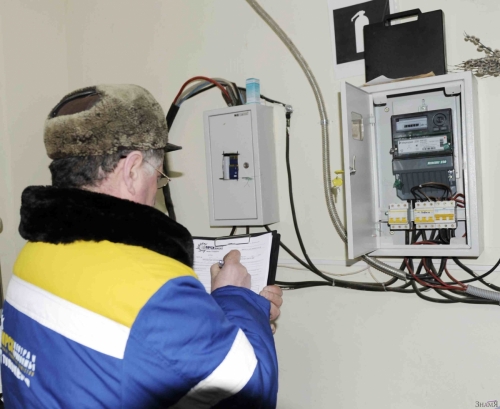
Important! When replacing a meter in an apartment, you will need to provide a copy of the agreement concluded with the housing department.
Sometimes there are contentious issues, about who should pay for the replacement of the meter. Residents of municipally owned houses can count on a free replacement of electricity meters. Replacement of the metering device in a privatized house/apartment is paid by the owner of the apartment.
How to choose an electric meter. Classification of electrical appliances
Before buying a counter, you need to understand its structure and principle of operation. delve into specifications we will not use an electrical appliance, we will indicate the main parameters that you need to pay attention to.
Induction and electronic counters. Induction models have two coils: voltage and current. The magnetic field of the coils rotates the disc, which sets in motion the mechanism for calculating the energy consumed. The more electrical appliances are connected, the higher the current and voltage, the faster the disk rotates and the meter reading increases.
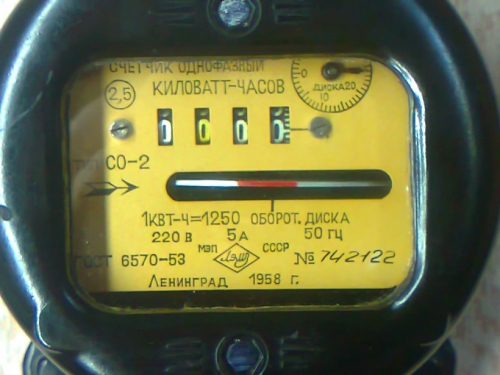
The advantages of induction meters are long service life (about 15 years) and reliable operation. Mechanical (induction) meters are the most popular.
Electronic drugs appeared later. They do not have moving elements, and the calculation of energy consumption is carried out using semiconductors or microcircuits. Voltage sensors transmit data on the amount of electricity used. Such counters are somewhat more expensive than mechanical ones, but their readings are more accurate. Additional benefits electronic counters:
- the possibility of multi-tariff accounting;
- ease of reading data - the presence of a digital indicator;
- it is difficult to implement attempts to steal electricity.
The main disadvantages of the electric meter: high price and limited service life.
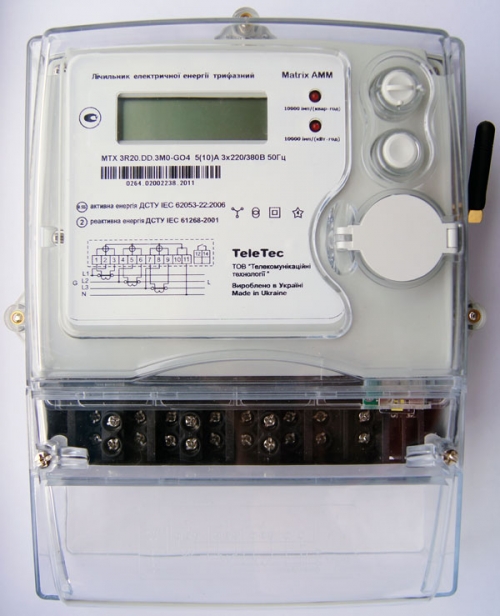
Both types of counter are presented in Russian stores. Individuals and organizations actively use both induction and electronic models. In the passports of most electric meters, an uninterrupted period of operation is indicated - 15 years. However, not a single sample has worked so much so far, because 15 years ago such models were not yet produced. Work resource mechanical counter breaks records - even after 50 years, many copies fit into a given level of accuracy and do not get out of the rest of the parameters.
Single-phase or three-phase meter. For powering apartments and private houses, as a rule, single-phase meters are used. Rated power household networks at a voltage of 220 V about 3-7 kW. Considering that 1 kW of power corresponds to a circuit current of 4.5 A, it is possible to calculate the current for which a single-phase device is designed - 13-32A.
Three-phase meters are widely used to account for the consumption of electricity for industrial enterprises, in municipal institutions, cottage villages, where input is allowed only on a three-phase system.
A high-quality three-phase meter has the following characteristics:
- the presence of an internal rater - a date and time accounting device that generates a load schedule and manages tariff transitions;
- built-in power profile - with breakdown by time remembers the highest power for a certain period;
- availability of a communication interface for transferring readings to a computer or communication center;
- event log for capturing surges and rises on each phase, changes in active and reactive energy, long power failures and voltage dips.

In addition to the above parameters, when choosing a new meter, you should consider:
- The accuracy class (0.2% - 2.5%) determines the level of measurement error. For residential premises, the accuracy rate should be at least 2%.
- Connection method. Meters can be connected via transformers or have direct connection. Meters for a current not exceeding 100 A are connected directly, if the load is greater - the device is switched on through a transformer with a secondary current of 5 A.
- Number of tariffs (one-, two- and multi-tariff). A two-tariff device allows you to save on payment - in daytime at one rate, at night - at reduced rates. The owners of such counters find profitable solutions, for example, running a washing machine or dishwasher at night, when the price of electricity is half that.
- Voltage class measuring device- 100 V or 200/300 V. If the house is powered by a high-voltage transmission line, then a meter with a secondary voltage of 100 V is installed, supplemented by a current transformer.
Important! To replace the electricity meter in an apartment, house, office and other premises, it is necessary to choose devices that are included in the State Register of Measuring Instruments of Russia. Each device approved by Russian standards is recorded in the registry under a unique number.
General requirements for the installation of an electric meter
Before installing new or replacing old electricity meters, careful preparation of the room where the meter is installed is required. Many indicators affect the accuracy and durability of the meter:
- temperature fluctuations;
- vibrations of various kinds;
- the composition of the surrounding air;
- humidity level, etc.

We list the mandatory conditions for the placement of electricity meters:
- the room must be dry;
- admissible temperature regime- from +°С to +40°С;
- the surfaces on which the meter is placed must have an acceptable degree of rigidity, not vibrate, not move or deform;
- it is permissible to place equipment on plastic, metal and wooden shields;
- fastening - exclusively on a vertical surface;
- allowable distance from the measuring device to the floor - 80-170 cm, optimally - placement at eye level;
- the slope of the counter should be no more than 1 °, otherwise the error of indications increases (this requirement is relevant for mechanical models);
- the size of the shield, cabinet, niche where the meter is installed is selected so that access to the device and reading the readings is not difficult;
- when connecting the wire, it is necessary to strip at least 12 mm;
- it is necessary to provide for the presence of automatic switches of the device - they will be required in the future when replacing or repairing the meter.
Replacing an old electricity meter with a new one: procedure
Single phase electricity meter
To install an electric meter, you can purchase a ready-made electrical panel equipped with the necessary elements. The second option is to purchase all the components separately, namely:
- counter;
- plastic/wooden/metal box for equipment placement;
- din rail;
- circuit breakers;
- three-core cable (minimum diameter - 3 mm);
- automatic switches;
- stainless steel screws with a wide hat, as an option, plastic dowels are suitable.
The general wiring diagram for a single-phase meter is as follows.
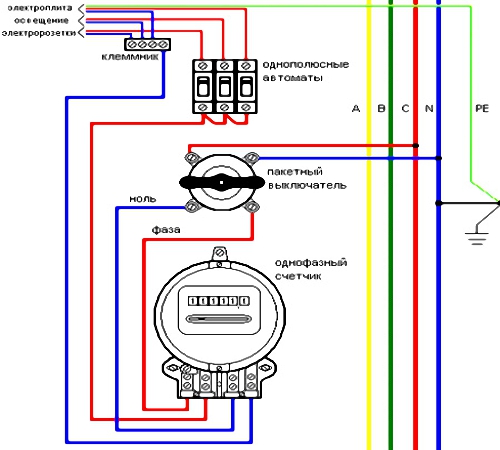
The procedure for replacing the electricity meter:
- Distribute everything in the shield necessary equipment. Such a “fitting” will make it clear whether the box is suitable in size and whether there will be any difficulties during the operation and maintenance of the electric meter.
- Mark places for the counter and DIN rail. Fix the elements according to the markup.
- Fix the circuit breakers on the rail.
- Carry out the wiring according to the scheme:
- bring the phase to the circuit breakers of consumer electrical appliances located in the room;
- determine the location of the phase according to the device diagram; to output the phase to different machines, cut the cable sheath, remove the brown and red leads; measure the segment depending on its placement (horizontal/vertical);
- strip the wire removed from the cable by 20 mm, insert the terminal and fix it with fasteners; from the side of the machine, strip the wire by no more than 10 mm;
- form p-shaped jumpers from the wires, clean the endings and connect the circuit breakers located nearby to the system; it is important to check that when connecting the wires lay without overlap, otherwise the joints will overheat;
- the next stage after connecting the phase is zero output; for this, a wire of any other color is used;
- measure out desired length wires from the meter to the copper plate; the terminal for zero is usually the fourth terminal from the left or the first terminal from the right;
- strip wires for zero and connect on both sides;
- after connecting the meter, attach the shield to the wall - mark the wall, drill holes and screw the shield with self-tapping screws;
- install grounding; steel shields are grounded according to the scheme: counter / shield / contact plate; shields made of non-conductive material are grounded directly to the plate.

Three-phase electricity meter
In areas with high energy consumption, measuring instruments With three-phase system. Such meters at the output give out not 220 V, but 380 V, which is necessary for the operation of some production equipment. Three-phase meters exclude voltage drops in the room where they are installed, as well as in neighboring buildings.
It is better to mount such meters in special panels with a platform and fixation with 3 screws. Installation of equipment is similar to connecting single-phase electricity meters. The schema looks like this:
![]()
- The power cable has three phases, a fifth grounding conductor and zero, which enters the electrical panel. The yellow phase is connected to the first contact, green - to the third, red - to the fifth. When turning on the phases, you must act carefully so as not to make a mistake. Phases are determined by trial and error or special device. After connecting one phase, the meter must be checked for errors. Continue in this manner until all wires are connected.
- Electricity is output from the 2nd, 4th, 6th contacts.
- Zero falls on 7, 8 contact.
- The ground conductor is fixed to a special bus. Zero is connected to ground - this will protect against network overvoltage.
Important! New copies of electronic meters are equipped with an addition that connects a system for remote transmission of readings. Such functionality causes additional contacts.
The act of replacing the electricity meter
Upon completion of the installation work, an Act of replacement of the meter is drawn up in two copies. The document contains the following information:
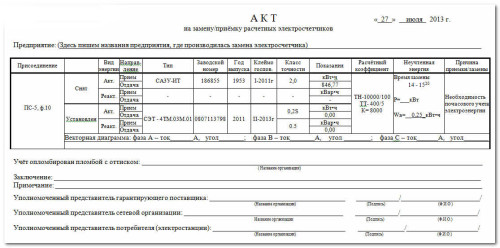
- name of the feeder where the replacement was made;
- type, year of manufacture, serial number and accuracy class of the new device;
- date of the last check of the old and new meters;
- electricity meter readings;
- unaccounted for electricity for the period of equipment replacement;
- reasons for replacement.
Assembling the electrical panel and installing the meter is not the easiest thing to do. During the installation process, it is necessary to competently and carefully approach the connection of wires. Manufacturers of electric meters on the cover of the terminal block indicate detailed diagram connection to be followed.
Replacing the electricity meter on the street: video
Each house is equipped with water, gas and electricity meters. It's no secret that all counters are required to be tested in certain deadlines and in case of failure must be replaced. Counters that are recognized as obsolete also fall under the replacement.
If you are faced with replacing the meter, then legal questions immediately arise. Technical nuances do not constitute great difficulties, compared with administrative moments. The main questions you face are:
- to whom to apply;
- who is the owner of the counter;
- what is the service life of this device;
- who and at whose expense should carry out the replacement.
Before answering the above questions, you should figure out: according to what law the replacement will be carried out, whether it is possible to do it yourself, who provides services for replacing electricity meters, how much the work costs and who will have to pay the bill.
The decision depends on the form of ownership of the housing. The meter can be replaced both in a private house and in a municipal one, as well as in a privatized apartment. In all three cases, the law provides for individual solutions.
Reasons for replacing an electricity meter
Previously, induction models of electricity meters were massively installed in all communal facilities. They were reliable and quite affordable. This type of old meters is still being installed in homes, given the new rules. After some time, the accuracy of the measurement and the current loads that are allowed have changed. Soviet meter models were valid up to 10A.
At present, the number of household electrical appliances in the houses has increased greatly. This was the reason that the meters simply could not withstand the load and failed ahead of time.
The accuracy of the readings has greatly decreased, in addition, the number of fires has increased due to these devices. Therefore, today all old-style counters are subject to replacement.
New regulations and laws have been adopted electric meters and their replacement. Instead of the old options, several alternatives to the new model have been developed. Among the main and most common:
- Induction electricity meters, but more modernized.
- Options that combine several types at the same time. For example, the calculation is made by the induction method, and the data is processed by electronics and displayed on the LCD screen.
- The whole device is electronic with LCD monitor.
- Digital multi-tariff devices.
All modern appliances electricity meters allow current load up to 60 A, have the 1st or 2nd accuracy class and can be in operation for up to 16 years.
Requirements for installing a meter
In order to replace the old one and install a new electric meter, a number of requirements have to be met. Among them:
- the electricity meter must be certified and pass state verification in special state bodies;
- the replaced meter must be sealed (for this, a special employee is invited from the power supply company who will install the seal, draw up a sealing act, where he will enter the date of installation, serial number device and readings with which the meter was installed);
- the height of the counter does not exceed 1.7 meters (such data is approved for the convenience of taking readings);
- there should be two seals on the electricity meter (one is hung on the casing by a representative of the metrology department of the Russian Federation, the second is placed at the bottom on the bottom cover by an energy supervision employee);
- the location of the device is selected convenient, dry and easily accessible. The presence of moisture near the meters is not allowed (usually electricity meters are installed on landings in high-rise buildings);
- the power of the meter must be corresponding to the power and strength of the electricity that passes through the consumer's power grid;
- accuracy classes of instruments are allowed not lower than the second;
- verification of the meter, which is planned to be installed instead of the old one, can be omitted in the metrology department if 2 years have not passed since the date of issue.
Models and types of electricity meters
 There are a number of models, both imported and domestic meters, that are allowed to be installed to replace the old ones. For example, an induction metering device SO-EE6706, which provides for the metering of electricity in a 220V network. More than a hundred years have passed since this type of electric meter was first released, so it has already been modified and modernized several times. This model is very reliable and durable. SO-I449 has the 2nd class of accuracy and allows current load up to 60A. A similar device is SO-505.
There are a number of models, both imported and domestic meters, that are allowed to be installed to replace the old ones. For example, an induction metering device SO-EE6706, which provides for the metering of electricity in a 220V network. More than a hundred years have passed since this type of electric meter was first released, so it has already been modified and modernized several times. This model is very reliable and durable. SO-I449 has the 2nd class of accuracy and allows current load up to 60A. A similar device is SO-505.
The modern model TsE-6807, designed for a 220V network, can be single or double tariff and has an accuracy of the 1st class.
The EC-2726 metering device is set to 4 tariffs, has the 1st accuracy class. The counter has a built-in clock where you can set the date and time, and also has its own personal power sources (batteries). The meter can work according to individual programs, there are 4 tariffs, 8 daily intervals, 12 seasons a year, 32 days off and holidays. The programmed programs can change automatically depending on the set tariff. The cost of this meter is higher than that of others, but thanks to it, the savings are also greater. This type of electric meter is not recommended to be installed on staircases on their own.
Data about taken testimony can be stored in the device's memory for up to 20 years. The information is displayed on the LCD screen. Thanks to such technologies, it is realistic to check the accuracy of the invoice for consumed electricity for any period of time. Manufacturers of such electricity meters give a guarantee for their work up to 30 years. The inspection must be carried out every 16 years.
Regulatory statutes
According to the Decree of the Government of the Russian Federation, No. 442 of 05/04/2012, outdated types of electricity meters, in case of failure, cannot be repaired. If 16 years have passed since the last state verification or the meter cannot be repaired, then such a device must be replaced. All new electricity meters must have 1st or 2nd accuracy class. The rules for replacing the electric meter can be found in a letter drawn up in 2000 by the State Energy Supervision Authority. It was approved by the State Standard of the Russian Federation.
In private houses and apartments that have been privatized, the replacement of metering devices is carried out at the expense of the owner of the housing. Counters that are located in the stairwells in high-rise buildings, are not the property of users. They are on the balance sheet of OSMD or ZhEKs, or belong to energy sales. In addition, electricity meters may be owned by the state or a private organization. Accounts for repairs or inspections are paid by the organizations on whose balance sheets the devices are located. An exception may be cases where the device has been damaged by the consumer.
Replacement of electricity meters can occur for various reasons.
The electricity meter might fail, maybe it might technically obsolete, or the subscriber of the power supply company may want to install a more modern multi-tariff device, which can significantly save money spent on electricity.
Dear readers! Our articles talk about typical solutions legal issues but each case is unique.
If you want to know how to solve exactly your problem - contact the online consultant form on the right or call free consultation:
However, the replacement of meters electrical energy very difficult, as there are many rules and laws that will have to comply with the owner or other subscriber of the energy supply company. Not many people know at whose expense the replacement of electricity meters in Moscow and other cities of Russia is carried out.
Should pensioners pay tax on a privatized apartment? find out right now.
What is regulated?
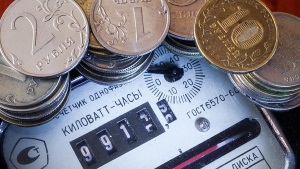
Maintenance and replacement of electricity meters regulated by Russian law:
- Art. 543 and Art. 210 of the Civil Code of the Russian Federation;
- housing code;
- federal law FZ No. 261 dated November 32, 2009;
- federal law FZ No. 102 dated 06/26/2008;
- decision of the State Standard of the Russian Federation;
- Decrees of the Government of the Russian Federation No. 530 and No. 491.
Who changes and at whose expense?
Do I need to change the electricity meter at my own expense? Depending on the location of the meter inside the apartment (private house) or in the entrance, responsibility for the condition and correct work electricity meters are either the owner of the dwelling or the management company.
In a private apartment
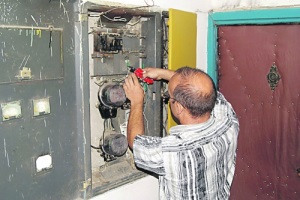
At the entrance

According to the Decree of the Government of the Russian Federation No. 491, electricity meters located on landings at the entrances apartment buildings, are .
Accordingly, all work and expenses for the replacement of electricity meters must be carried out the management company in whose department the residential building is located.
However, the law stipulates the possibility of payment for work by the owner of apartments, if such a provision is written in the contract between the owner of the dwelling and the management company.
If this is not specified in the contract, then all costs must be borne by the management company.
In a private house
The owner of a private house fully pays for the costs of replacing a failed electric meter in accordance with the Decree of the Government of the Russian Federation No. 530, since he is the owner of the property.
In those rare cases where the utility user resides in the municipal private sector, replacement of electricity meters is carried out in the same manner as in municipal non-privatized apartments.
Rules and deadlines
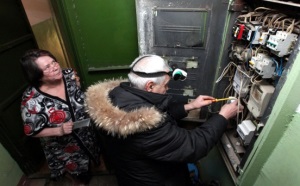
When replacing an electric meter, there are strict rules that must be followed.
In case of violation of the replacement procedure and violation of sealing you can get a significant fine, the re-accounting of paid energy at the maximum tariff for the last 3 years can also be made.
When appropriately contacted by the energy sales company, that obligated within 10 days send an electrician and replace the electric meter.
Electric meters are subject to replacement, the period of operation of which, according to their passport data, has expired. Outdated metering devices are also being replaced.
If broke
If the electric energy meter is out of order, then in no case should you try to fix it yourself, as the seals of the device manufacturer and the controlling organization will be violated, which entails penalties.
If a malfunction is detected, the owner or other subscriber must contact the power supply company and do the following:
- Write an application for the departure of a specialist, indicating the home address and signs of damage.
- Find out the time of arrival of a specialist from the dispatcher by phone.
- Wait for a specialist who will check the sealing and the technical condition of the device.
- If necessary, replace the electricity meter.
On the rules for the use of residential premises and common property V apartment buildings learn from our .
Can I replace myself?

Can I replace the meter myself? Theoretically possible independently or with the help of a familiar specialist to replace the electric meter.
With such a replacement, you should obtain official permission from the energy supply company, and removing the seal of the old meter must be done in the presence of a specialist from the management company.
At self replacement rules must be strictly followed technical security.
Procedure
How to change the electricity meter? When replacing an electricity meter follow the following procedure:
- you should contact the power supply organization and obtain permission to replace the electricity meter;
- you need to get a certificate, without which it will not be possible to purchase a counter in the store;
- you need to get permission to remove the seal from the management company (it is possible that the management company will send an observer);
- you need to select a suitable meter, approved by the energy sales company and technologically suitable to replace the old one;
- an electrician is sent by an energy supply company or is located independently (an electrician must have a 3rd electrical safety group);
- needs to be dismantled and stored old electricity meter for verification by a specialist of his data;
- next, install new counter and make sure it works properly.
- it is necessary to call the controller for verification and sealing.
Is a notification being sent?

If the initiator of the replacement of the electricity meter is the energy supply company, then the owner of the residential premises notification is sent, which informs about the need to replace the meter and instructs to purchase a meter and pay for its installation services.
This usually happens when the previous meter expires. In cases where replacement initiated by the owner of the apartment, he must apply to the power supply company with a corresponding application.
Drafting an application-claim from the owner in management company you can find on our website.
Checking and sealing
After installing a new electricity meter, the owner or subscriber of the energy supply company should to the maximum short time call a specialist who will check the operation of the device and seal it.
Without these procedures, the new electricity meter will not be accepted into operation.
To call a specialist, you should contact the management or energy supply company and pay for this service according to the receipt provided.
What documents are issued?

After installing a new meter and sealing it to the owner certificate of sealing is issued, which should be submitted to the management company to recalculate the cost of providing electricity.
Thus, if the electricity meter is located on landing, or is carried out in municipal housing, then the replacement of the meter is the prerogative of the management or energy company.
If the meter is installed in the owner's apartment, then replacing the device cost him a lot of money and during the dismantling and installation of a new device, the strict rules established by regulations and laws must be observed.
You can learn about the rules for replacing electricity meters from the video:




